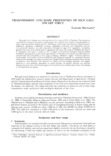Transmission and Some Properties of Rice Gall Dwarf Virus
Tropical agriculture research series : proceedings of a symposium on tropical agriculture researches
| ISSN | 03889386 |
|---|---|
| 書誌レコードID(総合目録DB) | AA00870529 |

本文フルテキスト
tars19-_154-159.pdf1.21 MB
Rice gall dwarf disease was observed for the first time in 1979 in Thailand. The symptoms consisted of stunting of rice plants, galls along veins of leaves and sheaths, reduced number of tillers, and retardation of plant growth. The disease which was transmitted bv Recilia dorsalis,Nephotettix nigropictus, Nephotettix cincticeps, Nephotettix malayanus and Nephotettix virescens in a persistent manner, was also transmitted through the eggs of N. nigropictus. Incubation period of the virus in R. dorsalis and N. nigropictus was about one week in Thailand and that in N. nigropictus was about 2 weeks at 25°C in Japan. Transmission efficiency showed marked differences among insect vector species and colonies. Of the plants inoculated, the following were infected and back-inoculated to rice: Oryza rufipogon, Hordeum vulgare, Triticum aestivum, Secale cereale, Avena saliva, Lolium multiflorum, and Alopecurus aequalis var. amurensis. No seed transmission through rice plants was detected. Double-shelled polyhedral particles about 65 nm in diameter were purified from infected rice plants and the purified particles were highly infectious to rice seedlings inoculated via insect nymphs. No specific reaction was detected between the new virus and antisera against the rive dwarf and wound tumor viruses that belong to the phytoreovirus group.
| 刊行年月日 | |
|---|---|
| 作成者 | Tadashi Morinaka |
| 公開者 | Japan International Research Center for Agricultural Sciences |
| 巻 | 19 |
| 開始ページ | 154 |
| 終了ページ | 159 |
| 言語 | eng |
